MANUAL OF ARMS.
134. The manual of arms will be taught to four men, placed, at first, in one rank, elbow to elbow, and afterwards in two ranks.
135. Each command will be executed in one time (or pause), but this time will be divided into motions) the better to make known the mechanism.
136. The rate (or swiftness) of each motion, in the manual of arms, with the exceptions herein indicated, is fixed at the ninetieth part of a minute, but, in order not to fatigue, the attention, the instructor will, at first, look more particularly to the execution of the motions, without requiring a nice observance of the cadence, to which he will bring the recruits progressively, and after they shall have become a little familiarized with the handling of the piece.
137. As the motions relative to the cartridge, to the rammer, and to the fixing and unfixing of the bayonet, cannot be executed at the rate prescribed, nor even with a uniform swiftness, they will not be subjected to that cadence. The instructor will, however, labor to cause these motions to be executed with promptness, and, above all, with regularity.
138. The last syllable of the command will decide the brisk execution of the first motion of each time (or pause). The commands two, three, and four, will decide the brisk execution of the other motions. As soon as the recruits shall well comprehend the positions of the several motions of a time, they will be taught to execute the time without resting on its different motions; the mechanism of the time will nevertheless be observed, as well to give a perfect use of the piece, as to avoid the sinking of, or slurring over, either of the motions.
139. The manual of arms will be taught in the following progression; the instructor will command:
Support—ARMS.
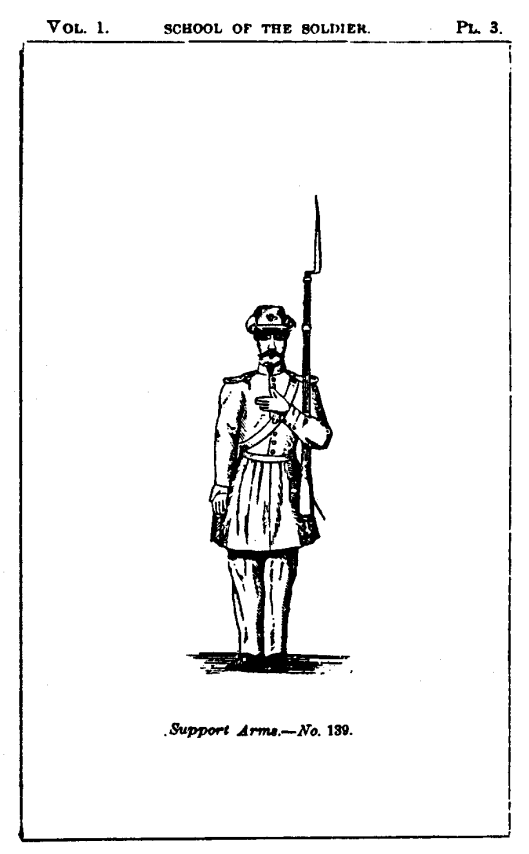
One time and three motions.
140. (First motion.) Bring the piece, with the right hand, perpendicularly to the front and between the eyes, the barrel to the rear; seize the piece with the left hand at the lower band, raise this hand as high as the chin, and seize the piece at the same time with the right hand four inches below the cock.
141. (Second motion.) Turn the piece with the right hand, the barrel to the front; carry the piece to the left shoulder, and pass the fore-arm extended on the breast between the right hand and the cock; support the cock against the left fore-arm, the left hand resting on the right breast.
142. (Third motion.) Drop the right hand by the side.
143. When the instructor may wish to give repose in this position, he will command: REST.
144. At this command, the recruits will bring up smartly the right hand to the handle of the piece (small of the stock), when they will not be required to preserve silence, or steadiness of position.
145. When the instructor may wish the recruits to pass from this position to that of silence and steadiness, he will command:
1. Attention. 2. SQUAD.
146. At the second word, the recruits will resume the position of the third motion of support arms.
Shoulder—ARMS.
One time and three motions.
147. (First motion.) Grasp the piece with the right hand under and against the left fore arm; seize it with the left hand at the lower band, the thumb extended; detach the piece slightly from the shoulder, the left fore-arm along the stock.
148. (Second motion.) Carry the piece vertically to the right shoulder with both hands, the rammer to the front, change the position of the right hand so as to embrace the guard with the thumb and fore-finger, slip the left hand to the height of the shoulder, the fingers extended and joined, the right arm nearly straight.
149. (Third motion.) Drop the left hand quickly by the side.
Present—ARMS.
One time and two motions.
150. (First motion.) With the right hand, bring the piece erect before the centre of the body, the rammer to the front; at the same time seize the piece with the left hand half-way between the guide sight and lower band, the thumb extended along the barrel and against the stock, the forearm horizontal and resting against the body, the hand as high as the elbow.
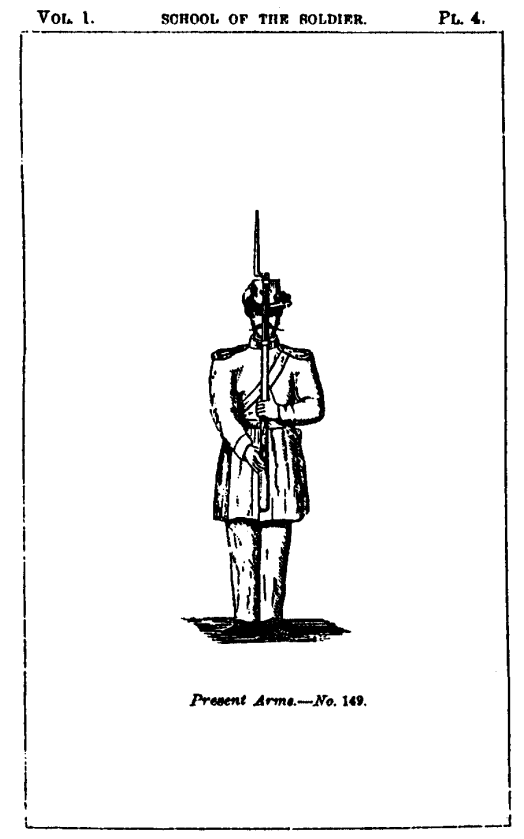
151. (Second motion.) Grasp the small of the stock with the right hand, below and against the guard.
Shoulder—ARMS.
One time and two motions.
152. (First motion.) Bring the piece to the right shoulder, at the same time change, the position of the right hand so as to embrace the guard with the thumb and fore-finger, slip up the left hand to the height of the shoulder, the fingers extended and joined, the right arm nearly straight.
153. (Second motion.) Drop the left hand quickly by the side.
Order—ARMS.
One time and two motions.
154. (First motion.) Seize the piece briskly with the left hand near the upper band, and detach it slightly from the shoulder with the right hand: loosen the grasp of the right hand, lower the piece with the left, reseize the piece with the right hand above the lower band, the little finger in the rear of the barrel, the butt about four inches from the ground, the right hand supported against the hip, drop the left hand by the side. If the rifle musket is used, the piece will be seized by the left hand a little above the middle band, and it will be seized by the right hand, just above the lower band.
155. (Second motion.) Let the piece slip through the right hand to the ground by opening slightly the fingers, and take the position about to be described.
POSITION OF ORDER ARMS.
156. The hand low, the barrel between the thumb and fore-finger extended along the stock; the other fingers extended and joined; the muzzle about two inches from the right shoulder; the rammer in front; the toe (or beak) of the butt, against, and in a line with, the toe of the right foot, the barrel perpendicular.
157. When the instructor may wish to give repose in this position, he will command: REST.
158. At this command, the recruits will not be required to preserve silence or steadiness.
159. When the instructor may wish the recruits to pass from this position to that of silence and steadiness, he will command:
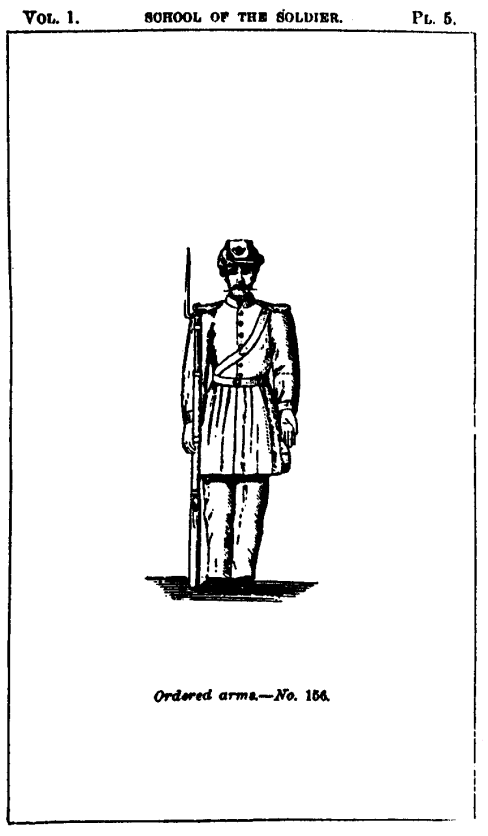
1. Attention. 2. SQUAD.
160. At the second word, the recruits will resume the position of order arms. Shoulder—ARMS.
One time and two motions.
161. (First motion.) Raise the piece vertically with the right hand to the height of the right breast, and opposite the shoulder, the elbow close to the body; seize the piece with the left hand below the right, and drop quickly the right hand to grasp the piece at the swell of the stock, the thumb and fore-finger embracing the guard; press the piece against the shoulder with the left hand, the right arm nearly straight.
162. (Second motion.) Drop the left hand quickly by the side.
LOAD IN NINE TIMES.
1. LOAD.
One time and one motion.
163. Grasp the piece with the left hand as high as the right elbow, and bring it vertically opposite the middle of the body, shift the right hand to the upper band, place the butt between the feet, the barrel to the front; seize it with the left hand near the muzzle, which should be three inches from the body; carry the right hand to the cartridge-box. If the rifle musket is used the right hand will be shifted to just below the upper band. The muzzle will be eight inches from the body.
2. Handle—CARTRIDGE.
One time and one motion.
164. Seize the cartridge with the thumb and next two fingers, and place it between the teeth.
3. Tear—CARTRIDGE.
One time and one motion.
165. Tear the paper to the powder, hold the cartridge upright between the thumb and first two fingers, near the top; in this position place it in front of and near the muzzle – the back of the hand to the front.
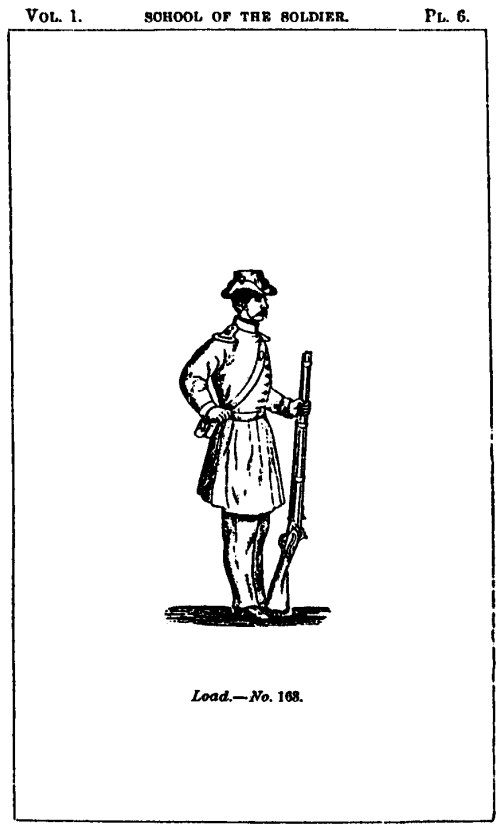
4. Charge—CARTRIDGE.
One time and one motion.
166. Empty the powder into the barrel: disengage the ball from the paper with the right hand and the thumb and first two fingers of the left; insert it into the bore, the pointed end uppermost, and press it down with the right thumb; seize the head of the rammer with the thumb and fore-finger of the right hand, the other fingers closed, the elbows near the body.
5. Draw—RAMMER.
One time and three motions.
167. (First motion.) Half draw the rammer by extending the right arm; steady it in this position with the left thumb; grasp the rammer near the muzzle with the right hand, the little finger uppermost, the nails to the front, the thumb extended along the rammer.
168. (Second motion.) Clear the rammer from the pipes by again extending the arm; the rammer in the prolongation of the pipes.
169. (Third motion.) Turn the rammer, the little end of the rammer passing near the left shoulder; place the head of the rammer on the ball, the back of the hand to the front.
6. Ram—CARTRIDGE.
One time and one motion.
170. Insert the rammer as far as the right, and steady it in this position with the thumb of the left hand; seize the rammer at the small end with the thumb and fore-finger of the right hand, the back of the band to the front; press the ball home, the elbows near the body.
7. Return—RAMMER.
One time and three motions.
171. (First motion.) Draw the rammer half-way out, and steady it in this position with the left thumb; grasp it near the muzzle with the right hand, the little finger uppermost, the nails to the front, the thumb along the rammer: clear the rammer from the bore by extending the arm, the nails to the front, the rammer in the prolongation of the bore.
172. (Second motion.) Turn the rammer, the head of the rammer passing near the left shoulder, and insert it in the pipes until the right hand reaches the muzzle, the nails to the front.
173. (Third motion.) Force the rammer home by placing the little finger of the right hand on the head of the rammer; pass the left hand down the barrel to the extent of the arm, without depressing the shoulder.
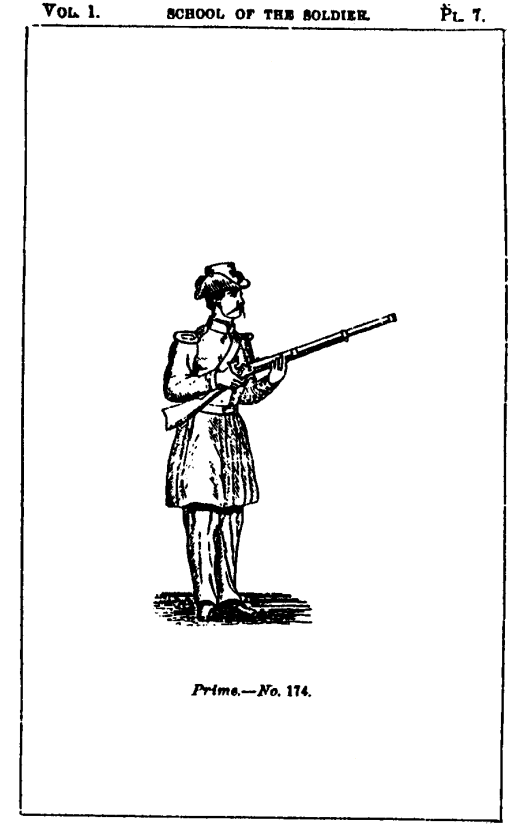
8. PRIME.
One time and two motions.
174. (First motion.) With the left hand raise the piece till the band is as high as the eye, grasp the small of the stock with the right hand; half face to the right; place, at the same time, the right foot behind and at right angles with the left; the hollow of the right foot against the left heel. Slip the left hand down to the lower band, the thumb along the stock, the left elbow against the body; bring the piece to the right side the butt below the right fore-arm – the small of the stock against the body and two inches below the right breast, the barrel upwards, the muzzle on a level with the eye.
175. (Second motion.) Half cock with the thumb of the right hand, the fingers supported against the guard and the small of the stock remove the old cap with one of the fingers of the right hand, and with the thumb and forefinger of the same hand, take a cap from the pouch, place it on the nipple, and press it down with the thumb; seize the small of the stock with the right hand.
9. Shoulder—ARMS.
One time and two motions.
176. (First motion.) Bring the piece to the right shoulder and support it there with the left band, face to the front; bring the right heel to the side of and on a line with the left; grasp the piece with the right hand as indicated in the position of shoulder arms.
177. (Second motion.) Drop the left hand quickly by the side.
READY.
One time and three motions.
178. (First motion.) Raise the piece slightly with the right hand, making a half face to the right on the left heel; carry the right foot to the rear, and place it at right angles to the left, the hollow of it opposite to and against the left heel; grasp the piece with the left hand at the lower band and detach it slightly from the shoulder.
179. (Second motion.) Bring down the piece with both hands, the barrel upward, the left thumb extended along the stock, the butt below the right fore-arm the small of the stock against the body and two inches below the right breast, the muzzle as high as the eye, the left elbow against the side; place at the same time the right thumb on the head of the cock the other fingers wider and against the guard.
180. (Third motion.) Cock, and seize the piece at the small of the stock without deranging the position of the butt.
AIM.
One time and one motion.
181. Raise the piece with both hands, and support the butt against the right shoulder; the left, elbow down, the right as high as the shoulder; incline the head upon the butt, so that the right eye may perceive quickly the notch of the hausse, the front sight, and the object aimed at, the left eye closed, the right thumb extended along the stock, the fore-finger on the trigger.
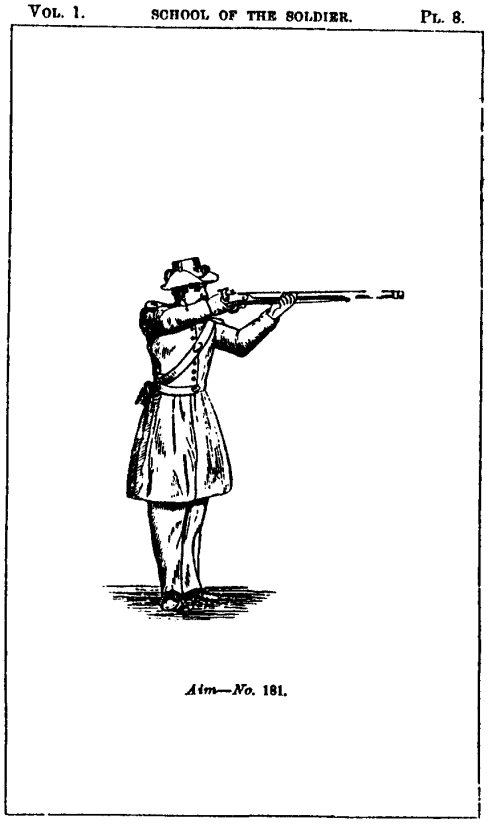
182. When recruits are formed in two ranks to execute the firings, the front-rank men will raise it, little less the right elbow, in order to facilitate the aim of the rear-rank men. 183. The rear-rank men, in aiming, will each carry the right foot about eight inches to the right, and towards the left heel of the man next it the right, inclining the upper part of the body forward.
FIRE.
One time and one motion.
184. Press the fore-finger against the trigger, fire, without lowering or turning the head, and remain in this position.
185. Instructors will be careful to observe when the men fire, that they aim at some distinct object, and that the barrel be so directed that the line of fire and the line of sight be in the same vertical plane. They will often cause the firing to be executed on ground of different inclinations, in order to accustom the men to fire at objects either above or below them.
LOAD.
One time and one motion.
186. Bring down the piece with both hands at the same time face to the front and take the position of load as indicated, No. 163. Each rear-rank man will bring his right foot by the side of the left.
187. The men being in this position, the instructor will cause the loading to be continued by the commands and means prescribed, No. 163, and following.
188. If, after firing, the instructor should not wish the recruits to reload, he will command:
Shoulder—ARMS.
One time and one motion.
189. Throw up the piece briskly with the left hand and resume the position of shoulder arms, at the same time face to the front, turning on the left heel, and bring the right heel on a line with the left.
190. To accustom the recruits to wait for the command fire, the instructor, when they are in the position of aim, will command:
Recover—ARMS.
One time and one motion.
191. At the first part of the command, withdraw the finger from the trigger; at the command arms, retake the position of the third motion of ready.
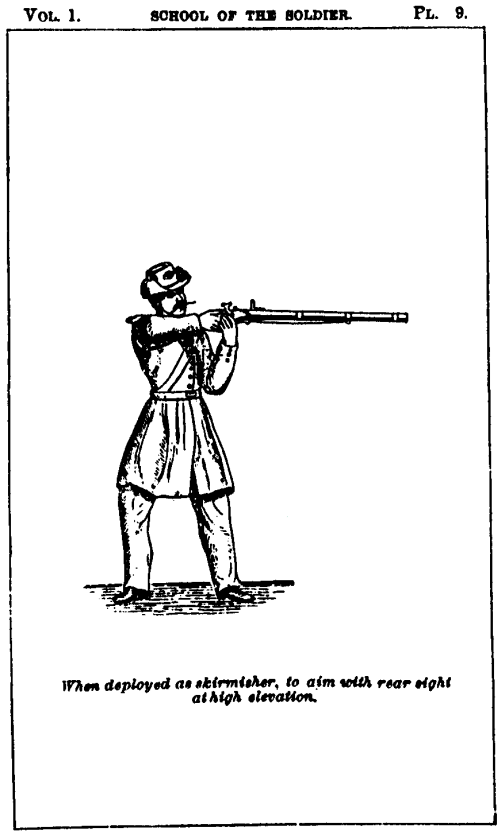
192. The recruits being in the position of the third motion of ready, if the instructor should wish to bring them to a shoulder, he will command:
Shoulder—ARMS.
One time and one motion.
193. At the command shoulder, place the thumb upon the cock, the fore-finger on the trigger, half cock, and seize the small of the stock with the right hand. At the command arms, bring up the piece briskly to the right shoulder, and retake the position of shoulder arms.
REMARKS ON LOADING AND FIRING.
194. Whenever the loadings and firings are to be executed, and the cartridge-boxes are slung upon the waist-belt, the instructor will cause them to be brought to the front. 195. If Maynard’s primer be used the command will be
Load in eight times.
and the eighth command will be shoulder arms, and executed from return rammer in one time and two motions, as follows:
(First motion.) Raise the piece with the left hand, and take the position of shoulder arms as indicated No. 152.
(Second motion.) Drop the left hand quickly by the side.
196. The recruits being at shoulder arms, when the instructor shall wish to fix bayonets, he will command:
Fix—BAYONET.
One time and three motions.
197. (First motion.) Grasp the piece with the left hand at the height of the shoulder, and detach it slightly from the shoulder with the right hand.
198. (Second motion.) Quit the piece with the right hand, lower it with the left hand, opposite the middle of the body, and place the butt between the feet without shock; the rammer to the rear, the barrel vertical, the muzzle three inches from the body; seize it with the right hand at the upper band, and carry the left hand reversed to the handle of the bayonet. If the rifle musket be used the barrel will be inclined forward, the muzzle eight inches from the body, and the left hand reversed to the handle of the bayonet.
199. (Third motion.) Draw the bayonet from the scabbard and fix it on the extremity of the barrel; seize the piece with the left hand, the arm extended, the right hand at the upper band. If the rifle musket be used the clasp will be turned as soon as the bayonet is fixed upon the barrel.
Shoulder—ARMS.
One time and two motions.
200. (First motion.) Raise the piece with the left hand and place it against the right shoulder, the rammer to the front: seize the piece at the same time with the right hand at the swell of the stock, the thumb and fore-finger embracing the guard, the right arm nearly extended. 201. (Second motion.) Drop briskly the left hand by the side.
Charge—BAYONET.
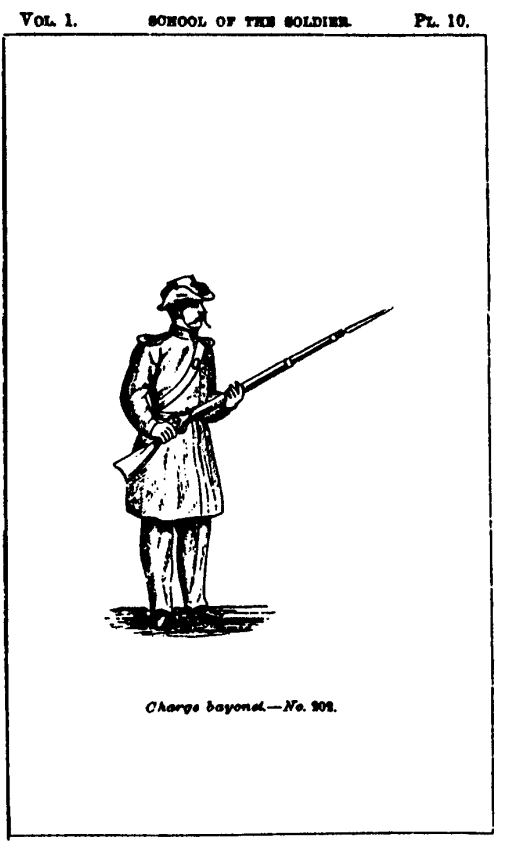
One time and two motions.
202. (First motion.) Raise the piece slightly with the right hand and make a half face to the right on the left heel; place the hollow of the right foot opposite to, and three inches from the left heel, the feet square; seize the piece at the same time with the left hand a little above the lower band.
203. (Second motion.) Bring down the piece with both hands, the barrel uppermost, the left elbow against the body; seize the small of the stock, at the same time, with the right hand, which will be supported against the hip; the point of the bayonet as high as the eye.
Shoulder—ARMS.
One time and two motions.
204. (First motion.) Throw up the piece briskly with the left band in facing to the front, place it against the right shoulder, the rammer to the front; turn the right hand so as to embrace the guard, slide the left hand to the height of the shoulder, the right hand nearly extended. 205. (Second motion.) Drop the left hand smartly by the side.
Trail—ARMS.
One time and two motions.
206. (First motion.) The same as the first motion of order arms.
207. (Second motion.) Incline the muzzle slightly to the front, the butt to the rear and about four inches from the ground. The right hand supported at the hip, will so hold the piece that the rear-rank men may not touch with their bayonets the men in the front-rank.
Shoulder—ARMS.
208. At the command shoulder, raise the piece perpendicularly in the right hand, the little finger in the rear of the barrel; at the command arms, execute what has been prescribed for the shoulder from the position of order arms.
Unfix—BAYONET.
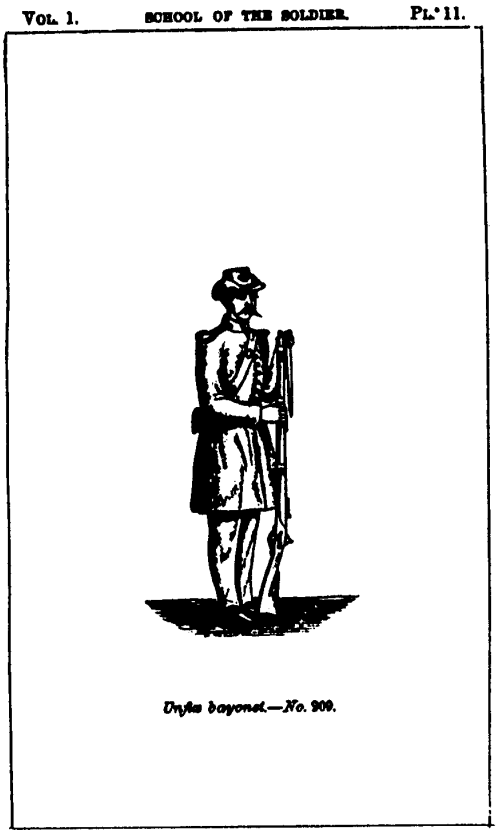
One time and three motions.
209. (First and second motions.) The same as the first and second motions of fix bayonet, except that, at the end of the second command, the thumb of the right hand will be placed on the spring of the sabre-bayonet, and the left hand will embrace the handle of the sabre bayonet and the barrel, the thumb extended along the blade. If the rifle musket is used, at the end of the second command turn the clasp of the bayonet by pressing against it with the thumb of the left hand, and then grasp the socket of the bayonet with the left hand, the shank resting between the thumb and fore-finger, the thumb pointed up.
210. (Third motion.) Press the thumb of the right hand on the spring, wrest off the sabre bayonet, turn it to the right, the edge to the front, lower the guard until it touches the right hand, which will seize the back and the edge of the blade between the thumb and first two fingers, the other fingers holding the piece; change the position of the hand without quitting the handle, return the sabre-bayonet to the scabbard, and seize the piece with the left hand, the arm extended. If the rifle musket is used, the following will be the method, viz.: (Third motion.) Wrest off the bayonet, turn it to the right, bringing the point of the bayonet down; change the position of the hand without quitting hold of the shank of the socket, return the bayonet to the scabbard, and seize the piece with the left hand, the arm extended.
Shoulder—ARMS.
One time and two motions.
211. (First motion.) The same as the first motion from fix bayonet, No. 200. 212. (Second motion.) The same as the second motion from fix bayonet, No. 201.
Secure—ARMS.
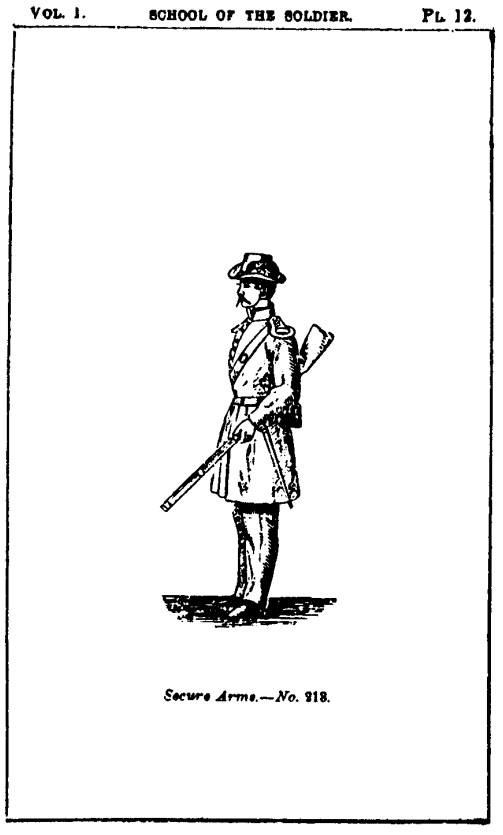
One time and three motions.
213. (First motion.) The same as the first motion of support arms, No. 140, except with the right hand seize the piece at the small of the stock.
214. (Second motion.) Turn the piece with both hands, the barrel to the front; bring it opposite the left shoulder, the butt against the hip, the left hand at the lower band the thumb as high as the chin and extended on the rammer; the piece erect and detached from the shoulder, the left fore-arm against the piece.
215. (Third motion.) Reverse the piece, pass it under the left arm, the left hand remaining at the lower band, the thumb on the rammer to prevent it from sliding out, the little finger resting against the hip, the right hand falling at the same time by the side.
Shoulder—ARMS.
One time and three motions.
216. (First motion.) Raise the piece with the left hand, and seize it with the right hand at the small of the stock. The piece erect and detached from the shoulder, the butt against the hip, the left fore-arm along the piece.
217. (Second motion.) The same as the second motion of shoulder arms from a support.
218. (Third motion.) The same as the third motion of shoulder arms from a support.
Right shoulder shift—ARMS.
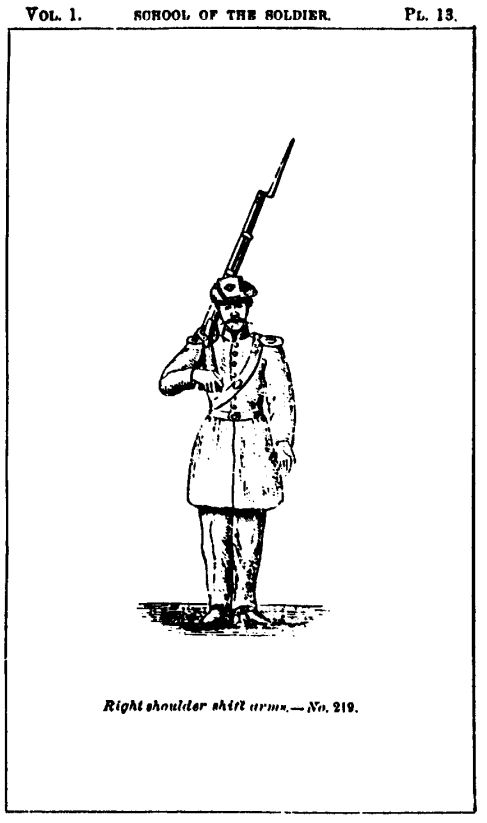
One time and two motions.
219. (First motion.) Detach the piece perpendicularly from the shoulder with the right hand, and seize it with the left between the lower band and guide-sight, raise the piece, the left hand at the height of the shoulder and four inches from it; place, at the same time, the right hand on the butt, the beak between the first two fingers, the other two fingers under the butt plate.
220. (Second motion.) Quit the piece with the left hand, raise and place the piece on the right shoulder with the right hand, the lock plate upward; let fall at the same time, the left hand by the side.
Shoulder—ARMS.
One time and two motions.
221. (First motion.) Raise the piece perpendicularly by extending the right arm to its full length, the rammer to the front; at the same time seize the piece with the left hand between the lower band and guide sight.
222. (Second motion.) Quit the butt with the right hand, which will immediately embrace the guard, lower the piece to the position of shoulder arms, slide up the left hand to the height of the shoulder, the fingers extended and closed. Drop the left hand by the side.
223. The men being at support arms, the instructor will sometimes cause pieces to be brought to the right shoulder. To this effect he will command:
Right shoulder shift—ARMS.
One time and two motions.
224. (First motion.) Seize the piece with the right hand, below and near the left fore-arm, place the left hand under the butt, the heel of the butt between the first two fingers. 225. (Second motion.) Turn the piece with the left hand, the lock plate upward, carry it to the right shoulder, the left hand still holding the butt, the muzzle elevated; hold the piece in this position and place the right hand upon the butt, as is prescribed No. 219, and let fall the left hand by the side.
Support—ARMS.
One time and two motions.
226. (First motion.) The same as the first motion of shoulder arms, No. 221.
227. (Second motion.) Turn the piece with both hands, the barrel to the front, carry it opposite the left shoulder, slip the right hand to the small of the stock, place the left fore-arm extended on the breast, as is prescribed No. 141, and let fall the right hand by the side.
Arms—AT WILL.
One time and one motion.
228. At this command, carry the piece at pleasure on either shoulder, with one or both hands, the muzzle elevated.
Shoulder—ARMS.
One time and one motion.
229. At this command, retake quickly the position of shoulder arms.
230. The recruits being at ordered arms, when the instructor shall wish to cause the pieces to be placed on the ground, he will command:
Ground—ARMS.
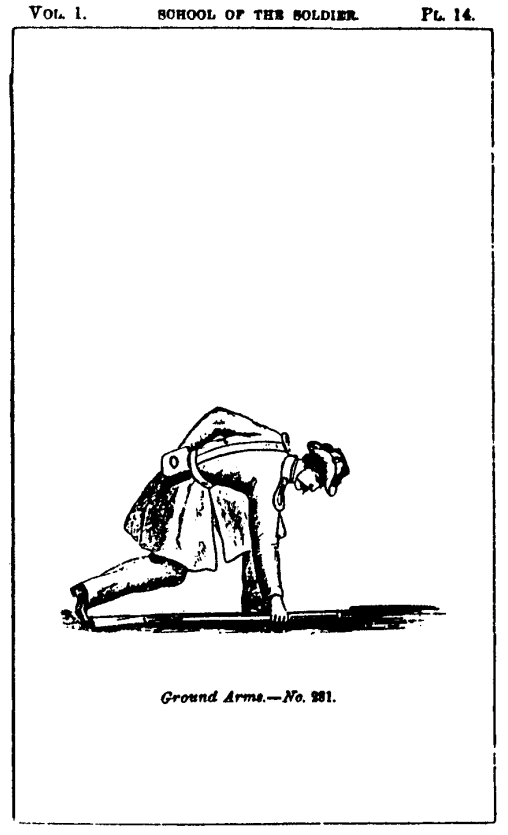
One time and two motions.
231. (First motion.) Turn the piece with the right hand, the barrel to the left, at the same time seize the cartridge box with the left hand, bend the body, advance the left foot, the heel opposite the lower band; lay the piece on the ground with the right hand, the toe of the butt on a line with the right toe, the knees slightly bent, the right heel raised.
232. (Second motion.) Rise up, bring the left foot by the side of the right, quit the cartridge box with the left hand, and drop the hands by the side.
Raise—ARMS.
One time and two motions.
233. (First motion.) Seize the cartridge box with the left hand, bend the body, advance the left foot opposite the lower band, and seize the piece with the right hand. 234. (Second motion.) Raise the piece, bringing the left foot by the side of the right; turn the piece with the right hand, the rammer to the front; at the same time quit the cartridge box with the left hand, and drop this hand by the side.
INSPECTION OF ARMS.
235. The recruits being at ordered arms, and having the bayonet in the scabbard, if the instructor wishes to cause an inspection of arms, he will command:
Inspection—ARMS.
One time and two motions.
236. (First motion.) Seize the piece with the left hand below and near the upper band, carry it with both bands opposite the middle of the body, the butt between the feet, the rammer to the rear, the barrel vertical, the muzzle about three inches fromthe body; (should the rifle musket be used, the muzzle will be about eight inches from the body); carry the left hand reversed to the bayonet, draw it from the scabbard and fix it on the barrel; grasp the piece with the left band below and near the upper band, seize the rammer with the thumb and fore-finger of the right hand bent, the other fingers closed.
237. (Second motion.) Draw the rammer as has been explained in loading, and let it glide to the bottom of the bore, replace the piece with the left hand opposite the right shoulder, and retake the position of ordered arms.
238. The instructor will then inspect in succession the piece of each recruit, in passing along the front of the rank. Each, as the instructor reaches him, will raise smartly his piece with his right hand, seize it with the left between the lower band and guide sight, the lock to the front, the left hand at the height of the chin, the piece opposite to the left eye; the instructor will take it with the right hand at the handle and, after inspecting it, will return it to the recruit, who will receive it back with the right hand, and replace it in the position of ordered arms.
239. When the instructor shall have passed him, each recruit will retake the position prescribed at the command inspection, return the rammer, unfix the bayonet, and resume the position of ordered arms.
240. If, instead of inspection of arms, the instructor should merely wish to cause bayonets to be fixed, he will command:
Fix—BAYONET.
241. Take the position indicated No. 236, fix bayonets as has been explained, and immediately resume the position of ordered arms.
242. If it be the wish of the instructor, after firing, to ascertain whether the pieces have been discharged, he will command:
Spring—RAMMERS.
243. Put the rammer in the barrel, as has been explained above, and immediately retake the position of ordered arms.
244. The instructor, for the purpose stated, can take the rammer by the small end, and spring it in the barrel, or cause each recruit to make it ring in the barrel.
245. Each recruit, after the instructor passes him, will return rammer, and resume the position of ordered arms.
REMARKS ON THE MANUAL OF ARMS.
246. The manual of arms frequently distorts the persons of recruits before they acquire ease and confidence in the several positions. The instructor will therefore frequently recur to elementary principles in the course of the lessons.
247. Recruits are also extremely liable to curve the sides and back, and to derange the shoulders, especially in loading. Consequently, the instructor will not cause them to dwell too long at a time in one position.
248. When, after some days of exercise in the manual of arms, the four men shall be well established in their use, the instructor will always terminate the lesson by marching the men for some time in one rank, and at one pace apart, in common and quick time, in order to confirm them more and more in the mechanism of the step; he will also teach them to mark time, and to change step, which will be executed in the following manner:
TO MARK TIME.
249. The four men marching in the direct step, the instructor will command: 1. Mark time. 2. MARCH.
250. At the second command, which will be given at the instant a foot is coming to the ground, the recruits will make a semblance of marching, by bringing the heels by the side of each other, and observing the cadence of the step, by raising each foot alternately without advancing. 251. The instructor wishing the direct step to be resumed, will command:
1. Forward. 2. MARCH.
252. At the second command, which will be given as prescribed above, the recruits will retake the step of twenty-eight inches.
TO CHANGE STEP.
253. The squad being in march, the instructor will command:
1. Change step. 2. MARCH.
254. At the second command, which will be given at the instant either foot is coming to the ground, bring the foot which is in rear by the side of that which is in front, and step off again with the foot which was in front.
TO MARCH BACKWARD.
255. The instructor wishing the squad to march backward, will command: 1. Squad backward. 2. MARCH.
256. At the second command, the recruits will step off smartly with the left foot fourteen inches to the rear, reckoning from heel to heel, and so with the feet in succession till the command halt, which will always be preceded by the caution squad. The men will halt at this command, and bring back the foot in front by the side of the other.
257. This step will always be executed in quick time.
258. The instructor will be watchful that the recruits march straight to the rear, and that the erect position of the body and the piece be not deranged.
